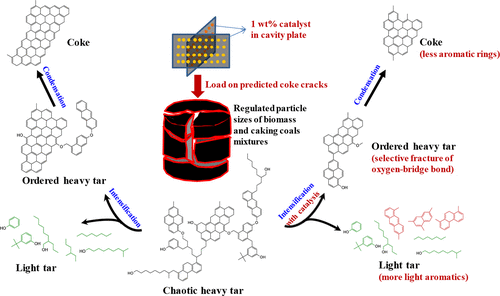当前位置:
X-MOL 学术
›
Ind. Eng. Chem. Res.
›
论文详情
Our official English website, www.x-mol.net, welcomes your
feedback! (Note: you will need to create a separate account there.)
In-Situ Catalytic Upgrading of Tar and Coke during Biomass/Coal Co-pyrolysis
Industrial & Engineering Chemistry Research ( IF 3.8 ) Pub Date : 2020-01-07 , DOI: 10.1021/acs.iecr.9b06626 Zhirong Yang 1, 2 , Jing Zhang 1 , Jiejie Huang 2 , Gang Qian 1 , Xuezhi Duan 1 , Xinggui Zhou 1
Industrial & Engineering Chemistry Research ( IF 3.8 ) Pub Date : 2020-01-07 , DOI: 10.1021/acs.iecr.9b06626 Zhirong Yang 1, 2 , Jing Zhang 1 , Jiejie Huang 2 , Gang Qian 1 , Xuezhi Duan 1 , Xinggui Zhou 1
Affiliation

|
To promote biomass-derived tar and coke upgrading, biomass pyrolysis intensification was utilized by the co-pyrolysis of biomass and caking coal with suitable particle size. The intensification led to a 15% increase in light tar fraction in tar, indicating a transformation from heavy tar to light components (phenols, aliphatic hydrocarbons). Moreover, the resulting coke achieved high strength (M25 > 80%) that can meet the requirement for moving bed gasification. To further facilitate tar upgrading and alleviate secondary reactions of volatiles that result in more secondary-coke and less gas, calcium-based Ca@Cu catalysts were synthesized and then loaded along the predicted coke cracks to improve tar quality without compromising coke granularity and strength. The results indicated that the catalytic upgrading mitigated the formation of pyrolytic water and secondary-coke, and dramatically improved tar quality as the light tar fraction in tar increased by 15–30%. Specifically, the upgraded light tar contains more phenols, naphthalenes, and anthracenes but less acids, ketones, and furfurals. It was postulated that selective cleavage of oxygen-containing functional groups (mainly ether bonds) promoted tar reconstruction to release more light aromatics during the catalysis. The coke strength continued to increase by 3–6%, possibly due to mitigation of H2O formation as indicated by more oxygen-containing groups retained in the aromatics during the Ca@Cu catalysis. The current study provided a new strategy to simultaneously upgrade coke and tar during catalytic pyrolysis of biomass for efficient utilization of the biomass.
中文翻译:

生物质/煤共热解过程中焦油和焦炭的原位催化降解
为了促进源自生物质的焦油和焦炭的升级,通过生物质与焦煤的共热解,利用适当粒径的生物质热解强化技术。强化导致焦油中轻质焦油含量增加15%,表明从重质焦油向轻质成分(酚,脂族烃)的转化。而且,所得焦炭达到了高强度(M 25> 80%),可以满足移动床气化的要求。为了进一步促进焦油的升级并减少导致更多二次焦炭和更少气体的挥发物的二次反应,合成了钙基Ca @ Cu催化剂,然后将其沿预测的焦炭裂纹装载,以改善焦油质量,而不会影响焦炭的粒度和强度。结果表明,随着焦油中轻质焦油含量增加15-30%,催化升级可减轻热解水和二次焦的形成,并显着改善焦油质量。具体而言,升级后的轻质焦油包含更多的酚,萘和蒽,而较少的酸,酮和糠醛。据推测,含氧官能团(主要是醚键)的选择性裂解促进了焦油重构,从而在催化过程中释放出更多的轻质芳族化合物。焦炭强度继续提高了3–6%,这可能是由于减少了H2由多个含氧基团所指示ö形成钙@铜催化期间保持在芳烃。当前的研究提供了一种新的策略,可以在生物质催化热解过程中同时升级焦炭和焦油,以有效利用生物质。
更新日期:2020-01-07
中文翻译:

生物质/煤共热解过程中焦油和焦炭的原位催化降解
为了促进源自生物质的焦油和焦炭的升级,通过生物质与焦煤的共热解,利用适当粒径的生物质热解强化技术。强化导致焦油中轻质焦油含量增加15%,表明从重质焦油向轻质成分(酚,脂族烃)的转化。而且,所得焦炭达到了高强度(M 25> 80%),可以满足移动床气化的要求。为了进一步促进焦油的升级并减少导致更多二次焦炭和更少气体的挥发物的二次反应,合成了钙基Ca @ Cu催化剂,然后将其沿预测的焦炭裂纹装载,以改善焦油质量,而不会影响焦炭的粒度和强度。结果表明,随着焦油中轻质焦油含量增加15-30%,催化升级可减轻热解水和二次焦的形成,并显着改善焦油质量。具体而言,升级后的轻质焦油包含更多的酚,萘和蒽,而较少的酸,酮和糠醛。据推测,含氧官能团(主要是醚键)的选择性裂解促进了焦油重构,从而在催化过程中释放出更多的轻质芳族化合物。焦炭强度继续提高了3–6%,这可能是由于减少了H2由多个含氧基团所指示ö形成钙@铜催化期间保持在芳烃。当前的研究提供了一种新的策略,可以在生物质催化热解过程中同时升级焦炭和焦油,以有效利用生物质。











































 京公网安备 11010802027423号
京公网安备 11010802027423号